If you’re reading this article, you’re probably having trouble generating quality leads for your business. You’re not alone. Many marketers consider lead generation their biggest challenge.
With so many resources claiming to have the best lead generation strategies, deciding on what to do can be confusing. This article will explore seven effective lead generation techniques you can use to help generate more leads for your business.
1. Use social media remarketing to re-engage website visitors
Much has been written about using social media as an initial touchpoint for creating leads. While Facebook and other social networks are highly effective in attracting customer attention, you can use remarketing to reach out to leads who might have fallen out of the funnel.
When we talk about remarketing, we refer to a form of digital marketing that serves ads to users who have visited your website but did not perform your desired action. It’s easy to set up a remarketing campaign for Facebook and other platforms.
To create a remarketing campaign, Facebook allows you to create custom audiences based on website traffic, app activity, or other types of behavior. The code will automatically download a cookie to the visitor’s device and add the user to your retargeting list whenever a user visits your site.
When the user goes to their social media feed, they then see an ad for your business. For example, when you visit the Vue Glasses website, you can expect to see the ad below in your feed:

By rolling out a social media remarketing campaign, you give your business a second (or more) chance to reach out to site visitors and convert them to leads.
2. Know which type of paid ads to use for specific sales funnel stages
You can’t rely entirely on organic searches or social media marketing to generate traffic and leads for your business. If you want to expand your reach while targeting potential customers at various buyer journey stages, you need to look into using paid ads.
However, regardless of your prospects’ location in the sales funnel, using generic paid ads won’t give you the results you need. On the other hand, marketing content that shows up at the right time will help you generate the leads your business needs.
Let’s look at the sales funnel stages and the types of paid ads you can run for each. The sales funnel is a proven marketing model that considers human psychology to help you develop more effective marketing campaigns.
Awareness
At the top of the sales funnel, people are not aware of your business or what you do. They probably need help with something, but don’t know of any solutions for their problems. You need to raise awareness of their pain points for this stage of the funnel and introduce your brand.
Many of these potential customers start by asking a question on Google. For instance, someone who would like to learn a foreign language will run a search like this:
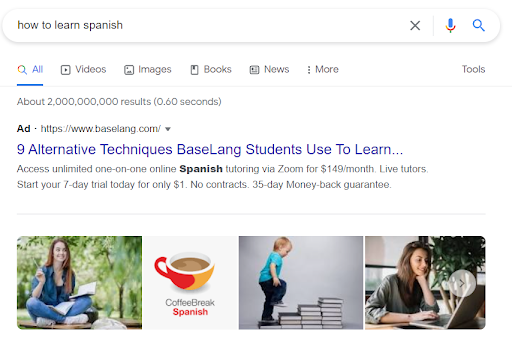
The ad above doesn’t promote BaseLang.com’s Spanish lessons but instead promotes an article about different methods its students use to learn the language. That answers the Google user’s intent, which is to discover ways to learn Spanish.
Prominent dog breeding platform, breedingbusiness.com, is another great example of using content to strategically funnel leads to their site. Founder, Lazhar Ichir says, “At Breeding Business, we keep our platform content regularly updated with rich content that answers a wide variety of top googled questions to directly answer our target audience’s queries and direct them to our site. It’s highly effective.”
Interest
Once the prospect becomes aware of your brand, you need to get them interested in your offer. At this point, you’re not yet supposed to sell anything. Instead, you need to engage with your future customers.
Baselang continues its customer funnel by giving prospective students a few Spanish phrases that could be useful in a conversation:
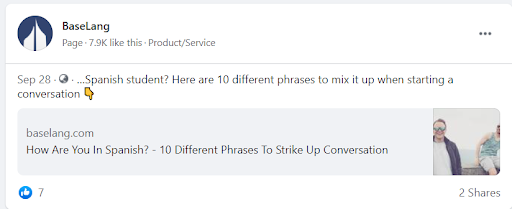
You may use Google Ads to display your site in searches for keywords that are relevant to your business. You may also use Facebook Remarketing along with ads on third-party sites, especially for users who might have been curious about your brand and visited your site once or twice.
Desire
Once someone shows their interest in your product, you need to help that lead know more about it. You can use a variety of approaches to make your leads want to try your product. For example, you can use YouTube content to promote user testimonials.
BaseLang uses testimonials to promote their one-week trial classes for just $1:

Through paid ads, you can promote not just your product but also the user experience.
Action
In the Action stage of the sales funnel, you need to convert the lead into a paying customer by convincing them that your product is worth the price tag. You may also retarget customers who have gone to your website and initiated a purchase but did not push through with it.
In this example, Baselang features a review from one of their students. What’s interesting with this review is that the student did the review mostly in Spanish after studying it for just six months.
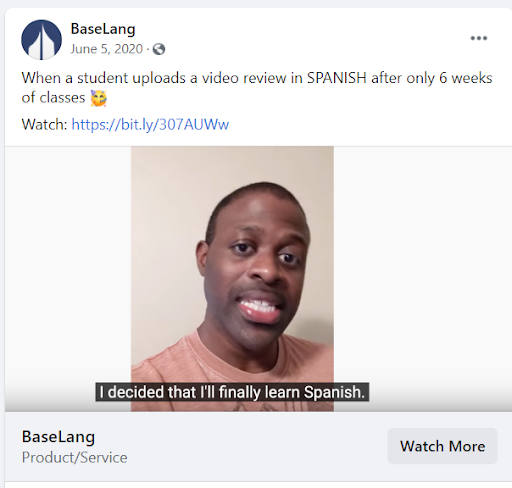
Clicking on the ad leads you to a YouTube video that features a link to a signup form. The website also notifies site visitors whenever someone signs up for online Spanish classes:

Using paid ads across different platforms will allow you to “guide” a potential customer through the sales funnel and give you a better chance of converting them into paying customer.
3. Focus on SEO
Search Engine Optimization involves on-site actions and off-site link building. You need to identify relevant keywords that you want to target, write SEO-optimized content, and then build links to that content to make it rank.
Thankfully, it’s becoming significantly easier to do all of the above, thanks to the great range of SEO tools companies have developed. In terms of keyword research, tools like SEMrush, Ahrefs, and others are really useful.
One approach to keyword research is reviewing top-performing pages for companies in your niche. For example, with Ahrefs, you can look at which terms are driving the most traffic to their site. Ahrefs then provides a scoring system that helps you assess how difficult it would be to rank for those terms.
You can use this strategy to identify keywords you might want to rank for but aren’t that important for your business. Here’s an example below of the type of results Ahrefs provides.
You’d want to skip a term like “business name ideas” unless it’s really important for your business. It’s just going to take too much time and effort to make your content rank.
Once you’ve created a list of keywords to target, create an editorial calendar for SEO.
Next, you’ll need to write your SEO-optimized content. Tools like Surfer, Clearscope, and others have made creating such content a lot easier. They use a Google Natural Language Processing API call to identify the most important terms and headings to include in your article.
Those terms will provide a framework you can use regarding the article structure, and the keywords you should include. That’s really useful.
Finally, you’ll probably have to build backlinks to your site. There are various ways you can do this from broken link building to guest post outreach. This guide provides a nice overview of how to guest post if you want to research this topic further.
4. Initiate referral and affiliate partnerships to widen your reach
A customer referral or affiliate program essentially makes your customers your marketing team. It’s an excellent way to generate leads as people are generally more likely to believe a message from an existing customer than one from a company. However, you need to ensure that your products and incentives are enticing if you wish to use referral marketing to expand your reach.
Chewy is a good example of a business that uses referral and affiliate partnerships to promote its products. It maintains programs on some of the largest affiliate platforms and offers well-known pet food and treat brands.
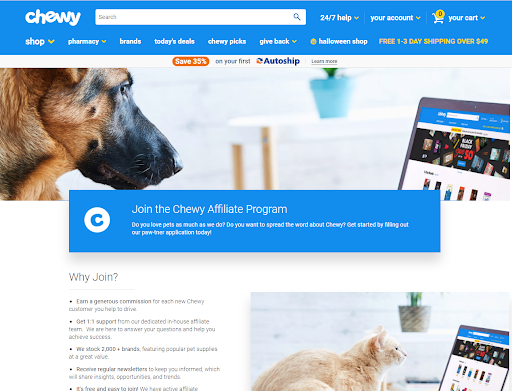
Some brands in the pet niche offer commissions as high as 16% to their referral and affiliate partners. On the other hand, Chewy offers a flat commission of up to $20 per new customer. Chewy’s advantage is that it carries over 2,000 best-known pet care brands and has a robust community of affiliate partners.
Chewy’s program is effective because it follows a set of easy-to-understand rules. For example, it defines a “new” customer as one who hasn’t purchased from Chewy since 2012. It is also open to partnering with content creators who meet their criteria.
Finally, they let potential affiliates choose between two affiliate networks – Partnerize and CJ Affiliate – known for their reporting interfaces and ease of use.
5. Establish industry leadership with online events
Virtual events and webinars are some of the most effective ways to generate leads for your business. They are certainly more cost-effective than offline events.
Brands that host online events spend less on technical equipment, venue rental, transport, accommodations, and other expenses. Online events are also accessible to more potential customers than offline events. Attendees don’t need to contend with the cost of plane tickets, hotel rooms, and meals.
Even though they are cheaper, they are still remarkably effective. You can use online events to establish industry leadership and generate business leads by exchanging digital business cards.
Performance management software vendor Betterworks is a good example of a business that has benefited from a shift to online events. In 2020, they decided to host their annual Goal Summit online.
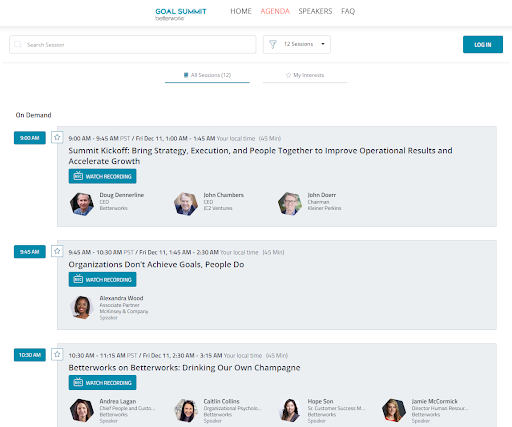
The one-day event featured speakers from different industries, such as tech, consulting, and education. Registered attendees could access sessions and breakout sessions.
Hosting online events is a very effective strategy for lead generation. You should run online events alongside offline events to access a wide audience.
6. Experiment with paid and free trials
One of the best ways to generate new leads for your business is to provide your service for free initially. Plenty of software companies use this model. Agencies can also use this model to gain the trust of potential clients.
While free trials play an important role in converting prospects into paying customers, many companies struggle with the business model. A study conducted by Totango in 2016 found that only 20% of free trial users eventually upgrade to a paid plan.
That means that four out of five people never invest in the service.
An alternative to the free trial model is a paid trial at a reduced price. Ahrefs uses this model, charging people around $7 for seven days. That’s a fraction of the regular price. It’s a nice strategy because it attracts qualified leads while dissuading people who are just looking to try the service for free.
7. Clean and segment your email list for more targeted campaigns
An email list is a good opportunity to generate a lot of new leads. For every dollar you spend on email marketing, you can get a return on investment of around $36. However, you need to take the right approach to get these kinds of results.
For instance, sending emails to fake email addresses will result in a high bounce rate, which in turn reduces your sender reputation. This means that your potential leads’ email providers are more likely to mark your emails as spam. Even if your emails make it past the spam filter, your recipients will probably ignore them if they never really intended to sign up, which could ultimately lead to your messages getting blocked.
In addition, people leave their jobs, change their email addresses, or simply stop using their email altogether. This phenomenon, known as email list decay, also affects your campaigns’ ability to reach their intended recipients.
You can employ a variety of measures to keep spambots and email list decay at bay. Using a reCAPTCHA in your subscriber forms will help verify if email signup was made by a human. You can also use a bulk email verification solution like Voila Norbert to check for fake email addresses.

After you’ve cleaned up your email list, you can start working on segmenting your list. Your list will probably be composed of individuals with varying interests and objectives, particularly if you’re trying to build a diverse customer base. Email segmentation will allow you to create targeted, personalized email campaigns. Here are a few ways to segment your email list:
- Geographical segmentation: This is probably the most common way of segmenting emails. Creating email list segments based on your subscribers’ location will allow you to send location-specific marketing content, such as invites to your events or holiday-based offers.
- Behavior-specific segmentation: This type of segmentation requires a bit of data collection. For example, you need to know about the pages they visited on your site, the content they read or downloaded, or the purchases they made. You won’t send a discount offer to someone who just mpurchasedfrom you.
- Role-based segmentation: If your business operates in the B2B (business to business) space, you will encounter people who occupy different roles in their workplaces. What would probably work with a C-level executive in a marketing firm won’t necessarily work with a sales manager in the software niche, simply because they have different goals.
By cleaning up and segmenting your email lists, you drastically increase the chances of your marketing content being opened and read by your potential leads.
Bottomline
So there you have it; seven essential tips to help increase leads for your business.
Note that these tips are not a nine-day wonder. The trick is to be consistent in implementing these strategies.
Many successful businesses have jump-started their brands using these exact strategies. If you want to generate more leads for your business, integrating these strategies into your marketing schemes is the way to go.
Author’s Bio

Matt Caron is a content marketer, writer, editor, manager, community builder, and UX/UI architect. At Ardent Growth, he helps companies create successful content and get the content ranking on Google.




